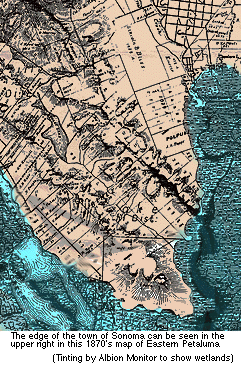| to "River Town" |
The Petaluma River meanders south from Petaluma to San Pablo Bay, the round bay just north of San Francisco Bay proper. It's a lazy, tidal waterway with more curves than a Slinky toy. But the lower reaches of the river used to be a lot wider. The alluvial plain it courses through, where a few latter-day farmers plant hay and other crops, used to be a lot marshier than it is now. In fact, it was more or less under water.
| |
One legacy of the California Gold Rush was hydraulic mining -- the practice of blasting the earth with water, sluicing away entire hillsides to extract small amounts of gold. Much of the loose soil went into streams; some of it ended up in the Sacramento River and washed up on the north shore of San Pablo Bay.
 By the 1870's, railroaders and land speculators had their eye on the
tidelands of that shore. A good deal of the marshy area was about five feet
above mean low tide -- great for herons, egrets and other waterbirds but
useless for farmers who wanted to plant crops.
By the 1870's, railroaders and land speculators had their eye on the
tidelands of that shore. A good deal of the marshy area was about five feet
above mean low tide -- great for herons, egrets and other waterbirds but
useless for farmers who wanted to plant crops.
John P. Jones was a 49er from Wales who had made a small strike in Trinity County, then pursued politics and banking before striking it rich in silver mining. In 1878 he formed the Pacific Reclamation Company and bought much of the tidal north shore of San Pablo Bay -- 10,400 unclaimed acres of marsh land just east of the Petaluma River. The land (located in the southeast corner of Sonoma County, south of what is now Sear's Point Raceway) included Tubbs Island, Skaggs Island, and four other islands, all of them separated by navigable sloughs.
Pacific Reclamation then hired Chinese workers, out of work since the completion of the Central Pacific Railroad. Pacific Rec issued them shovels and wheelbarrows and instructed them to build a dike that would wall off the tidelands from the bay. When it became clear that hand-labor was no match for the tide, the company built a floating steam dredge that hoisted a giant bucket. The dredge scooped mud from the mucky shore and piled it up into serviceable levees.
Once the tides from the bay no longer inundated the land, rain eventually leached away the salt, and farmers moved in to plant hay and other crops. A railroad line was built from San Rafael; it crossed the Petaluma River near its mouth at Black Point and halted at stops like Reclamation and Sears Point before meeting the main Sonoma Valley rail line at Schellville.
| |
Meanwhile, farther up the Petaluma Valley, farming practices aggravated the natural siltation of the river. As ranching took hold, eroded soil choked the already shallow, tidal waterway. As parts of the river bottom filled in, mariners found it harder and harder to dodge the sandbars.
From Olompali Park (one of the most important trading villages of the Coast Miwok), you can look out onto the Petaluma flood plain near Novato and see a wooded hill. Once an island in the wide lower reaches of the Petaluma River, "Hog Island" is now a knoll on the east bank.
At the turn of the century, the Petaluma River was the third busiest waterway in the state in terms of river commerce (after the Sacramento and San Joaquin Rivers).
Scow schooners, steamboats and barges snaked up the estuary to Petaluma's busy wharves. The last few shallow miles could be a real challenge: river crews were known to pole their way up the final stretch with 20-foot sticks. Where the riverbank was firm, the sailors would sometimes hop out of the boat, loop a line over their shoulders and tow the boat.
| |
Starting in the 1920's, trucks started taking more and more of the freight away from the scow schooners, barges and paddlewheelers. The last commercial run of a sternwheeler on the Petaluma River -- in all of California, in fact -- came on August 24, 1950. Skipper Jack Urton, who had a flair for the historic moment, wrote a final entry in his log: "Arr. Petaluma 10:45 . . . After 35 years, 8 mo. and 10 days, we tie up for good. This ends 103 years of sternwheel river navigation on SF Bay and tributaries."
Siltation is a challenge for the boats that still ply the river. Sailboat owners at the Petaluma Marina, a mile downstream from downtown Petaluma, have complained they get stuck at the bar between the marina and the river channel. Yacht owners sometimes find their propellers churning up mud instead of river water. Period dredging keeps the river open, but nature, having been rearranged by man, has a way of undoing all his work.
